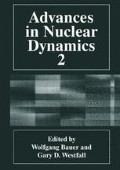Abstract
One of the still most challenging questions in nuclear physics is that of the equation of state (EOS) of nuclear matter — how does nuclear matter change properties under different temperatures and pressures?[1] Heavy-ion collisions are of great importance in this study; when two large nuclei collide, the nuclear matter is compressed, due to two-body collisions of the nuclear constituents also the temperature rises. Unlike for macroscopic matter, for nuclear matter. this state is unfortunately not directly observable: both the length and the time scale of nuclear collisions prohibit direct observation of nuclear matter while it is still at high temperature and density. Instead, nuclear matter has already cooled down, expanded, and formed more stable configurations before it hits the detectors.
Access this chapter
Tax calculation will be finalised at checkout
Purchases are for personal use only
Preview
Unable to display preview. Download preview PDF.
References
Czernai, L. P., and Kapusta, J. I., 1986, Entropy and cluster production in nuclear collisions, Phys. Rep. 131: 223;
Stock, R., 1986, Particle production m high energy nucleus-nucleus collisions, Phys. Rep. 135:259:
Gutbrod, H., et al., 1989, Plastic Ball experiments, Rep. Prog. Phys. 52: 1267.
Westfall, G. D., et al., 1993, Mass dependence of the disappearance of flow in nuclear collisions, Ph,ys. Rev. Lett. 71: 1986.
Das Gupta, S., and Westfall, G. D., 1993, Probing dense nuclear matter in the laboratory, Physics Today 46 (5): 34.
Aichelin, J., 1991, “Quantum” molecular dynamics. A dynamical microscopic n-body approach to investigate fragment formation and the nuclear equation of state in heavy ion collisions, Phys. Rep. 202:233;
Feldmeier, H., 1990, Fermionic molecular dynamics, Nucl. Phys. A 515: 147;
Ono, A., et al., 1992, Antisymmetrized version of Molecular Dynamics with two-nucleon collisions and its applications to heavy ion collisions, Prog. of Theoret. Phys. 87: 1185;
Sorge, H., Stöcker, H., and Greiner, W., 1989, Nuclear collisions at relativistic energies, Nucl. Phys. A 498: 567c;
Sorge, H., Stöcker, H., and Greiner, W., 1989, Poincaré invariant Hamiltonian dynamics, Ann. Phys. 192: 266.
Bertsch, G. F., and Das Gupta, S., 1988, A guide to microscopic models for intermediate energy heavy ion collisions, Phys. Rep. 160: 189;
Aichelin, J., 1986, Heavy systems at intermediate energies in the Boltzmann-Uehling-Uhlenbeck approach, Phys. Rev. C 33: 537;
Stöcker, H., and Greiner, W., 1986, High energy heavy ion collisions — probing the equation of state of highly excited hadronic matter, Phys. Rep. 137: 277;
Mosel, U., 1991, Subthreshold particle productions in heavy-ion collisions, Annu. Rev. Nucl. Part. Sci. 41: 29;
Bauer, W., Gelbke, C.-K., and Pratt, S., 1992, Hadronic interferometry in heavy-ion collisions, Annu. Rev. Nucl. Part. Sci. 42: 77;
Schuck, P., et al., 1989, Semiclassical and phase space approaches to dynamic and collisional problems of nuclei, Prog. Part. Neel. Phys. 22: 181;
Pang, Y., Schlagel, T., and Kahana, S. H., 1992, ARC — a relativistic cascade, Nucl. Phys. A 544: 435c;
Kahana, D. E., Keane, D., Pang, Y., Schlagel, T., and Wang, S., 1995, Collective flow from the intranuclear cascade model, Phys. Rev. Lett. 74: 4404.
Bauer, W., Bertsch, G. F., Cassing, W., and Mosel, U., 1986, Energetic photons from intermediate energy proton-and heavy-ion-induced reactions, Phys. Rev. C 34: 2127;
Bauer, W., 1987, Light particle correlations in heavy ion collisions, Nucl. Phys. A 471: 604;
Bauer, W., Bertsch, G. F., and Schulz, H., 1992, Bubble and ring formation in nuclear fragmentation, Phys. Rev. Lett. 69: 1888.
Lang, A., Badovsky, H., Cassing, W., Mosel, U., Reusch, H.-G., and Weber, K., 1993, A new treatment of Boltzmann-like collision integrals in nuclear kinetic equations, J. Comp. Phys. 106: 391.
Danielewicz, P., and Bertsch, G. F., 1992, Production of deuterons and pions in a transport model of energetic heavy-ion collisions, Nucl. Phys. A 533: 712 (Appendix).
Alexander, F. J., Garcia, A. L., and Alder, B. J., 1995, A consistent Boltzmann algorithm, Phys. Rev. Lett. 74: 5212.
Résibois, P. M., and De Leener, M., 1977, “Classical Kinetic Theory of Fluids,” p. 156ff, John Wiley Sons, New York.
Welke, G., Malflied, R., Grégoire, C., Prakash, M., and Suraud, E., 1989, Collisional relaxation in simulations of heavy-ion collisions using Boltzmann-type equations, Phys. Rev. C 40: 2611
Badovsky, H., 1989, Convergence proof of Nambu’s Boltzmann simulation scheme, Eur. J. Mech., B/Fluids 8: 41.
Danielewicz, P., and Pratt, S., 1996, Delays associated with elementary processes in nuclear reaction simulations, Phys. Rev. C, 53: 249
Danielewicz, P., 1995, Effects of compression and collective expansion on particle emission from central heavy-ion reactions, Phys. Rev. C 51: 716.
Gustafson, H. A., et al. (Plastic Ball Collaboration), 1988, Energy and multiplicity dependence of fragment flow in high energy nuclear collisions, Mod. Phys. Lett. A 3: 1323.
Partlan, M. D., 1995, et al. (EOS Collaboration), 1995, Fragment flow in Au+Au collisions, Phys. Rev. Lett. 75: 2100.
Kakow, D., Welke, G., and Bauer, W., 1993, Nuclear flow excitation function, Phys. Rev. C 48: 1982.
Alm, T., et al., 1995, The in-medium nucleon-nucleon cross section and BUU simulations of heavy-ion reactions, Neel. Phys. A 587: 815.
Author information
Authors and Affiliations
Editor information
Editors and Affiliations
Rights and permissions
Copyright information
© 1996 Springer Science+Business Media New York
About this chapter
Cite this chapter
Kortemeyer, G., Daffin, F., Bauer, W. (1996). A Study of Nuclear Flow in Consistent Boltzmann Algorithms. In: Bauer, W., Westfall, G.D. (eds) Advances in Nuclear Dynamics 2. Springer, Boston, MA. https://doi.org/10.1007/978-1-4757-9086-3_23
Download citation
DOI: https://doi.org/10.1007/978-1-4757-9086-3_23
Publisher Name: Springer, Boston, MA
Print ISBN: 978-1-4757-9088-7
Online ISBN: 978-1-4757-9086-3
eBook Packages: Springer Book Archive

